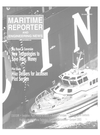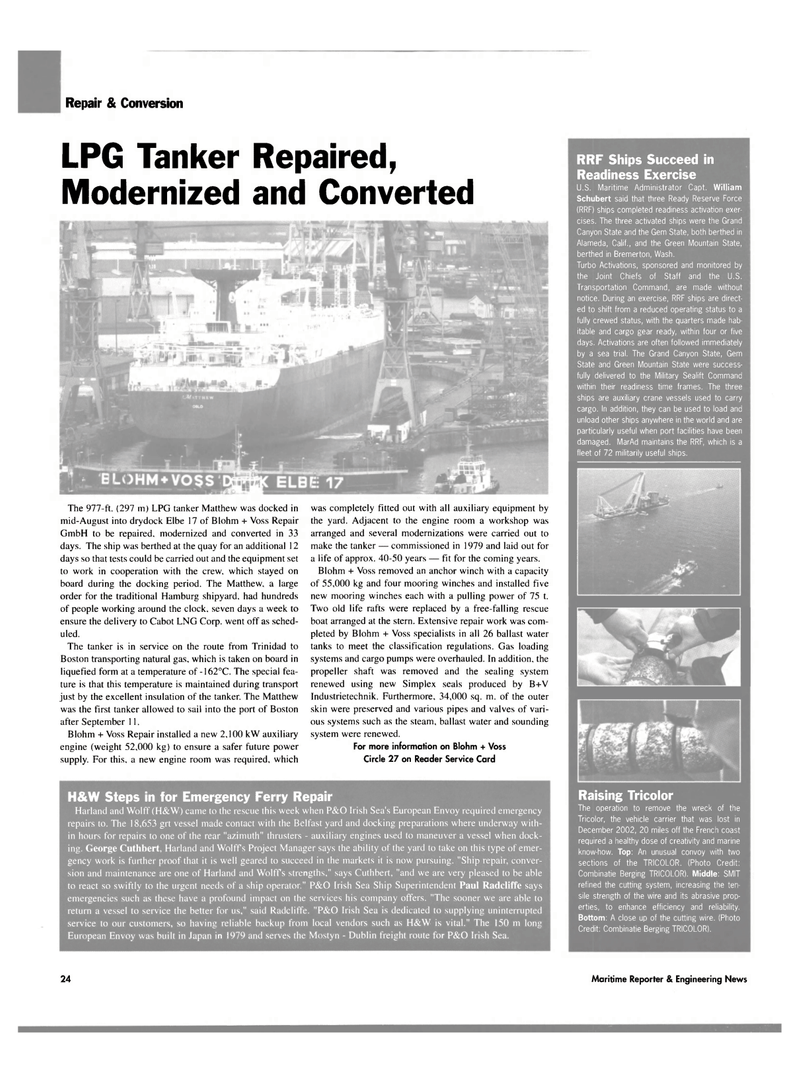
Page 26: of Maritime Reporter Magazine (October 2003)
Read this page in Pdf, Flash or Html5 edition of October 2003 Maritime Reporter Magazine
Repair & Conversion
RRF Ships Succeed in
Readiness Exercise
U.S. Maritime Administrator Capt. William
Schubert said that three Ready Reserve Force (RRF) ships completed readiness activation exer- cises. The three activated ships were the Grand
Canyon State and the Gem State, both berthed in
Alameda, Calif., and the Green Mountain State, berthed in Bremerton, Wash.
Turbo Activations, sponsored and monitored by the Joint Chiefs of Staff and the U.S.
Transportation Command, are made without notice. During an exercise, RRF ships are direct- ed to shift from a reduced operating status to a fully crewed status, with the quarters made hab- itable and cargo gear ready, within four or five days. Activations are often followed immediately by a sea trial. The Grand Canyon State, Gem
State and Green Mountain State were success- fully delivered to the Military Sealift Command within their readiness time frames. The three ships are auxiliary crane vessels used to carry cargo. In addition, they can be used to load and unload other ships anywhere in the world and are particularly useful when port facilities have been damaged. MarAd maintains the RRF, which is a fleet of 72 militarily useful ships.
LPG Tanker Repaired,
Modernized and Converted
The 977-ft. (297 in) LPG tanker Matthew was docked in mid-August into drydock Elbe 17 of Blohm + Voss Repair
GmbH to be repaired, modernized and converted in 33 days. The ship was berthed at the quay for an additional 12 days so that tests could be carried out and the equipment set to work in cooperation with the crew, which stayed on board during the docking period. The Matthew, a large order for the traditional Hamburg shipyard, had hundreds of people working around the clock, seven days a week to ensure the delivery to Cabot LNG Corp. went off as sched- uled.
The tanker is in service on the route from Trinidad to
Boston transporting natural gas, which is taken on board in liquefied form at a temperature of -162°C. The special fea- ture is that this temperature is maintained during transport just by the excellent insulation of the tanker. The Matthew was the first tanker allowed to sail into the port of Boston after September 11.
Blohm + Voss Repair installed a new 2,100 kW auxiliary engine (weight 52,000 kg) to ensure a safer future power supply. For this, a new engine room was required, which was completely fitted out with all auxiliary equipment by the yard. Adjacent to the engine room a workshop was arranged and several modernizations were carried out to make the tanker — commissioned in 1979 and laid out for a life of approx. 40-50 years — fit for the coming years.
Blohm + Voss removed an anchor winch with a capacity of 55,000 kg and four mooring winches and installed five new mooring winches each with a pulling power of 75 t.
Two old life rafts were replaced by a free-falling rescue boat arranged at the stern. Extensive repair work was com- pleted by Blohm + Voss specialists in all 26 ballast water tanks to meet the classification regulations. Gas loading systems and cargo pumps were overhauled. In addition, the propeller shaft was removed and the sealing system renewed using new Simplex seals produced by B+V
Industrietechnik. Furthermore, 34,000 sq. m. of the outer skin were preserved and various pipes and valves of vari- ous systems such as the steam, ballast water and sounding system were renewed.
For more information on Blohm + Voss
Circle 27 on Reader Service Card
H&W Steps in for Emergency Ferry Repair
Harland and Wolff (H&W) came to the rescue this week when P&O Irish Sea's European Envoy required emergency repairs to. The 18,653 grt vessel made contact with the Belfast yard and docking preparations where underway with- in hours for repairs to one of the rear "azimuth" thrusters - auxiliary engines used to maneuver a vessel when dock- ing. George Cuthbert, Harland and Wolffs Project Manager says the ability of the yard to take on this type of emer- gency work is further proof that it is well geared to succeed in the markets it is now pursuing. "Ship repair, conver- sion and maintenance are one of Harland and Wolffs strengths," says Cuthbert, "and we are very pleased to be able to react so swiftly to the urgent needs of a ship operator." P&O Irish Sea Ship Superintendent Paul Radcliffe says emergencies such as these have a profound impact on the services his company offers. "The sooner we are able to return a vessel to service the better for us," said Radcliffe. "P&O Irish Sea is dedicated to supplying uninterrupted service to our customers, so having reliable backup from local vendors such as H&W is vital." The 150 m long
European Envoy was built in Japan in 1979 and serves the Mostyn - Dublin freight route for P&O Irish Sea.
Raising Tricolor
The operation to remove the wreck of the
Tricolor, the vehicle carrier that was lost in
December 2002, 20 miles off the French coast required a healthy dose of creativity and marine know-how. Top: An unusual convoy with two sections of the TRICOLOR. (Photo Credit:
Combinatie Berging TRICOLOR). Middle: SMIT refined the cutting system, increasing the ten- sile strength of the wire and its abrasive prop- erties, to enhance efficiency and reliability.
Bottom: A close up of the cutting wire. (Photo
Credit: Combinatie Berging TRICOLOR). 24 Maritime Reporter & Engineering News

 25
25

 27
27
